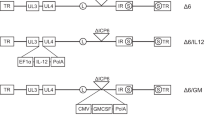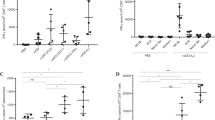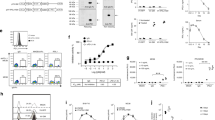Abstract
Antibody-targeted superantigen C215Fab-SEA is a fusion protein of staphylococcal enterotoxin A (SEA) and the Fab region of the tumor-reactive C215 mAb. It can trigger CTL against C215 antigen-positive tumor cells and induce tumor-suppressive cytokines. However, the antitumor effect of C215Fab-SEA is not satisfactory because of suboptimal production of Th1 cytokines after repeated administration. Interleukin 18 (IL-18) is a novel cytokine with profound effects on Th1 cellular response. In this study, we showed that adenovirus-mediated intratumoral IL-18 gene transfer strongly improved the therapeutic efficacy of C215Fab-SEA in the pre-established C215 antigen-expressing B16 melanoma murine model. More significant tumor inhibition and prolonged survival time were observed in tumor-bearing mice received combined therapy of C215Fab-SEA and Ad IL-18 than those of mice treated with C215Fab-SEA or AdIL-18 alone. Combination therapy augmented NK and CTL activities of tumor-bearing mice more markedly. The production of IL-2 and IFN-γ also increased more significantly. More potent antitumor effect of combined therapy was observed in IL-10 KO mice with enhanced Th1 response. Our data demonstrated that the antitumor effect of C215Fab-SEA immunotherapy could be potentiated significantly by combination with intratumoral IL-18 gene transfer through more efficient activation of Th1 immune responses.
This is a preview of subscription content, access via your institution
Access options
Subscribe to this journal
Receive 12 print issues and online access
$259.00 per year
only $21.58 per issue
Buy this article
- Purchase on Springer Link
- Instant access to full article PDF
Prices may be subject to local taxes which are calculated during checkout






Similar content being viewed by others
References
Klarnet JP et al. FBL-reactive CD8+ cytotoxic and CD4+ helper T lymphocytes recognize distinct Friend murine leukemia virus-encoded antigen J Exp Med 1989 169: 457–467
Kann M et al. CD4+ T cells clones specific for the human p97 melanoma-associated antigen can eradicate pulmonary metastases from a murine tumor expressing the p97 antigen J Immunol 1991 146: 3235–3241
Hom SS et al. Common expression of melanoma tumor-associated antigens recognized by human tumor infiltrating lymphocytes: analysis by human lymphocyte antigen restriction J Immunother 1991 10: 153–164
White J et al. The V beta-specific superantigen staphylococcal enterotoxin B: stimulation of mature T cells and clonal deletion in neonatal mice Cell 1989 56: 27–35
Fischer H et al. Production of TNF-alpha and TNF-beta by staphylococcal enterotoxin A activated human T cells J Immunol 1990 144: 4663–4669
Dohlsten M et al. Superantigen-induced cytokines suppress growth of human colon-carcinoma cells Int J Cancer 1993 54: 482–488
Dohlsten M et al. Immunopharcology of the superantigen staphylococcal enterotoxin A in T cell receptor V beta 3 trangenic mice Immunology 1993 79: 520–527
Dohlsten M et al. Monoclonal antibody-superantigen fusion proteins: tumor-specific agents for T-cell-based tumor therapy Proc Natl Acad Sci USA 1994 91: 8945–8949
Ihle J et al. Antibody-targeted superantigens induce lysis of major histocompatibility complex classII-negative T-cell leukemia lines Cancer Res 1995 55: 623–628
Lando PA et al. Tumor-reactive superantigens suppress tumor growth in humanized SCID mice Int J Cancer 1995 62: 466–471
Dohlsten M et al. Immunotherapy of human colon cancer by antibody-targeted superantigens Cancer Immunol Immunother 1995 41: 162–168
Dohlsten M et al. Antibody-targeted superantigens are potent inducers of tumor-infiltrating T lymphocytes in vivo Proc Natl Acad Sci USA 1995 92: 9791–9795
Litton MJ et al. Antibody-targeted superantigen therapy induces tumor-infiltrating lymphocytes, excessive cytokine production, and apoptosis in human colon carcinoma Eur J Immunol 1996 26: 1–9
Rosendahl A et al. Immune response during tumor therapy with antibody-superantigen fusion proteins Int J Cancer 1996 68: 109–113
Giantonio BJ et al. Superantigen-based immunotherapy: a phase I trial of PNU-214565, a monoclonal antibody-staphylococcal enterotoxin A recombinant fusion protein, in advanced pancreaticand colorectal cancer J Clin Oncol 1997 15: 1994–2007
Rosendahl A et al. Perforin and IFN-gamma are involved in the antitumor effects of antibody-targeted superantigens J Immunol 1998 160: 5309–5313
Nielsen SE et al. Phase I study of single, escalating doses of a superantigen-antibody fusion protein (PNU-214565) in patients with advanced colorectal or pancreatic carcinoma J Immunother 2000 23: 146–153
Rosendahl A et al. Long-term survival and complete cures of B16 melanoma-carrying animals after therapy with tumor-targeted IL-2 and SEA Int J Cancer 1999 81: 156–163
Sakurai M et al. Comparative study of the antitumor effect of two typrs of murine recombinant interferons (beta) and (gamma), against B16-F10 melanoma Cancer Immunol Immunother 1988 26: 109–113
Mareel M, Dragonetti C, Tavernier J, Fiers W . Tumor-selective cytotoxic effects of murine tumor necrosis factor (TNF) and interferon-gamma (IFN-gamma) in organ culture of B16 melanoma cells and heart tissue Int J Cancer 1988 42: 470–473
Okamura H et al. Cloning of a new cytokine that induces IFN-gamma production by T cells Nature 1995 378: 88–91
Micallef MJ et al. Interferon-gamma-inducing factor enhances T helper 1cytokine production by stimulated human T cells: synergism with interleukin-12 for interferon-gamma production Eur J Immunol 1996 26: 1647–1651
Dao T et al. Interferon-gamma-inducing factor, a novel cytokine, enhances Fas ligand-mediated cytotoxicity murine T helper 1 cells Cell Immunol 1996 173: 230–235
Micallef MJ et al. In vivo antitumor effects of murine interferon-gamma-inducing factor/interleukin 18 in mice bearing syngeneic Meth A sarcoma malignant ascites Cancer Immunol Immunother 1997 43: 361–367
Micallef MJ et al. Interleukin 18 induces the sequential activation of natural killer cells and cytotoxic T lymphocytes to protect syngeneic mice from transplantation with MethA sarcoma Cancer Res 1997 57: 4557–4563
Tasaki K et al. Protective immunity is induced in murine colon carcinoma cells by the expression of interleukin-12 or interleukin-18, which activate type 1 helper T cells Cancer Gene Ther 2000 7: 247–254
Kikuchi T et al. Antitumor activity of interleukin-18 on mouse glioma cells J Immunother 2000 23: 184–189
Yang X et al. IL-10 gene knock out mice show enhanced Th1-like protective immunity and absent granuloma formation following chlamydia trachomatis lung infection J Immunol 1999 162: 1010–1017
Bjork P et al. Isolation, partial characterization, and molecular cloning of a human colon adenocarcinoma cell-surface glycoprotein recognized by the C215 mouse monoclonal antibody J Biol Chem 1993 268: 24232–24241
Ju DW et al. Interleukin-18 gene transfer increases antitumor effects of suicide gene therapy through efficient induction of antitumor immunity Gene Therapy 2000 7: 1672–1679
Pardoll DM . Cancer vaccines Nature Med 1999 4: 525–531
Li Y et al. Costimulation of tumo-reactive CD4+ and CD8+ T lymphocytes by B7, a natural ligand for CD28, can be used to treat established mouse melanoma J Immunol 1994 153: 421–427
Lotze MT et al. Cytokine gene therapy of cancer Cancer 1996 2: 63–72
Bubenik J . Granulocyte-macrophage colony-stimulating factor gene-modified vaccines for immunotherapy of cancer Folia Biol (praha) 1999 45: 115–119
Blankenstein T, Qin Z . Cancer vaccine Gene Therapy 1996 3: 95–96
Belfrage H, Dohlsten M, Hedlund G, Kalland T . Prevention of superantigen-induced tolerance in vivo by interleukin-2 treatment Cancer Immunol Immunother 1997 44: 77–82
Nagai H et al. Antitumor effects on mouse melanoma elicited by local secretion of interleukin-12 and their enhancement by treatment with interleukin-18 Cancer Invest 2000 18: 206–213
Cao R, Farnebo J, Kurimoto M, Cao Y . Interleukin-18 acts as an angiogenesis and tumor suppressor FASEB J 1999 13: 2195–2202
Aruga A et al. Type 1 versus type 2 cytokine release by V beta T cell subpopulations determines in vivo antitumor reactivity:IL-10 mediates a suppressive one J Immunol 1997 159: 664–673
Litton MJ et al. The distinct role of CD4+ and CD8+ T-cells during the anti-tumor effects of targeted superantigens Br J Cancer 1999 81: 359–366
Sundstedt A et al. Immunoregulatory role of IL-10 during superantigen-induced hyporesponsiveness in vivo J Immunol 1997 158: 180–186
Fiorentino DF et al. IL-10 acts on the antigen-presenting cell to inhibit cytokine production by Th1 cells J Immunol 1991 146: 3444–3451
Ding L et al. IL-10 inhibits macrophage costimulatory activity by selectively inhibiting the up-regulation of B7 expression J Immunol 1993 151: 1224–1234
Oswald IP, Gazzinelli RT, Sher A, James SL . IL-10 synergizes with IL-4 and transforming growth factor-β to inhibit macrophage cytotoxic activity J Immunol 1992 148: 3578–3582
Groux H, Bigler M, de Vries JE, Roncarolo MG . Interleukin-10 induces a long-term antigen-specific anergic state in human CD4+ T cells J Exp Med 1996 184: 19–29
Fitzpatrick L, Makrigiannis AP, Kaiser M, Hoskin D . Anti-CD3-activated killer T cells: interferon-gamma and interleukin-10 cross-regulate granzyme B expression and the induction of major histocompatibity complex-unrestricted cytotoxicity J Interferon Cytokine Res 1996 16: 537–546
Masayuki U et al. Expression of mouse mammary tumor virus superantigen accelerates tumorigenicity of myeloma cells J Virol 2000 74: 8226–8233
Lei H et al. Induction of potent antitumor response by vaccination with tumor lysate-pulsed macrophages engineered to secret macrophage colony-stimulating factor and interferon-γ Gene Therapy 2000 7: 707–713
Acknowledgements
We would like to acknowledge the gifts of C215Fab-SEA, C242Fab-SEA, C215Mab, SEA, plasmid PKGE839 from Active Biotech Research AB (Sweden). This work was supported by grants from the National Natural Science Foundation of China (No. 39770837 and No. 39730420).
Author information
Authors and Affiliations
Additional information
H Yu, Cancer Institute, Zhejiang University, 68 Jiefang Road, Hangzhou, 310009, PR China
Rights and permissions
About this article
Cite this article
Wang, Q., Yu, H., Ju, D. et al. Intratumoral IL-18 gene transfer improves therapeutic efficacy of antibody-targeted superantigen in established murine melanoma. Gene Ther 8, 542–550 (2001). https://doi.org/10.1038/sj.gt.3301428
Received:
Accepted:
Published:
Issue Date:
DOI: https://doi.org/10.1038/sj.gt.3301428
Keywords
This article is cited by
-
Human TGFalpha-derived peptide TGFalphaL3 fused with superantigen for immunotherapy of EGFR-expressing tumours
BMC Biotechnology (2010)
-
Adenovirus-mediated LIGHT gene modification in murine B-cell lymphoma elicits a potent antitumor effect
Cellular & Molecular Immunology (2010)
-
Oncolytic adenovirus expressing interleukin-18 induces significant antitumor effects against melanoma in mice through inhibition of angiogenesis
Cancer Gene Therapy (2010)
-
Intratumoral delivery of IL-18 naked DNA induces T-cell activation and Th1 response in a mouse hepatic cancer model
BMC Cancer (2007)
-
Enhanced induction of dendritic cell maturation and HLA-A*0201-restricted CEA-specific CD8+ CTL response by exosomes derived from IL-18 gene-modified CEA-positive tumor cells
Journal of Molecular Medicine (2006)



